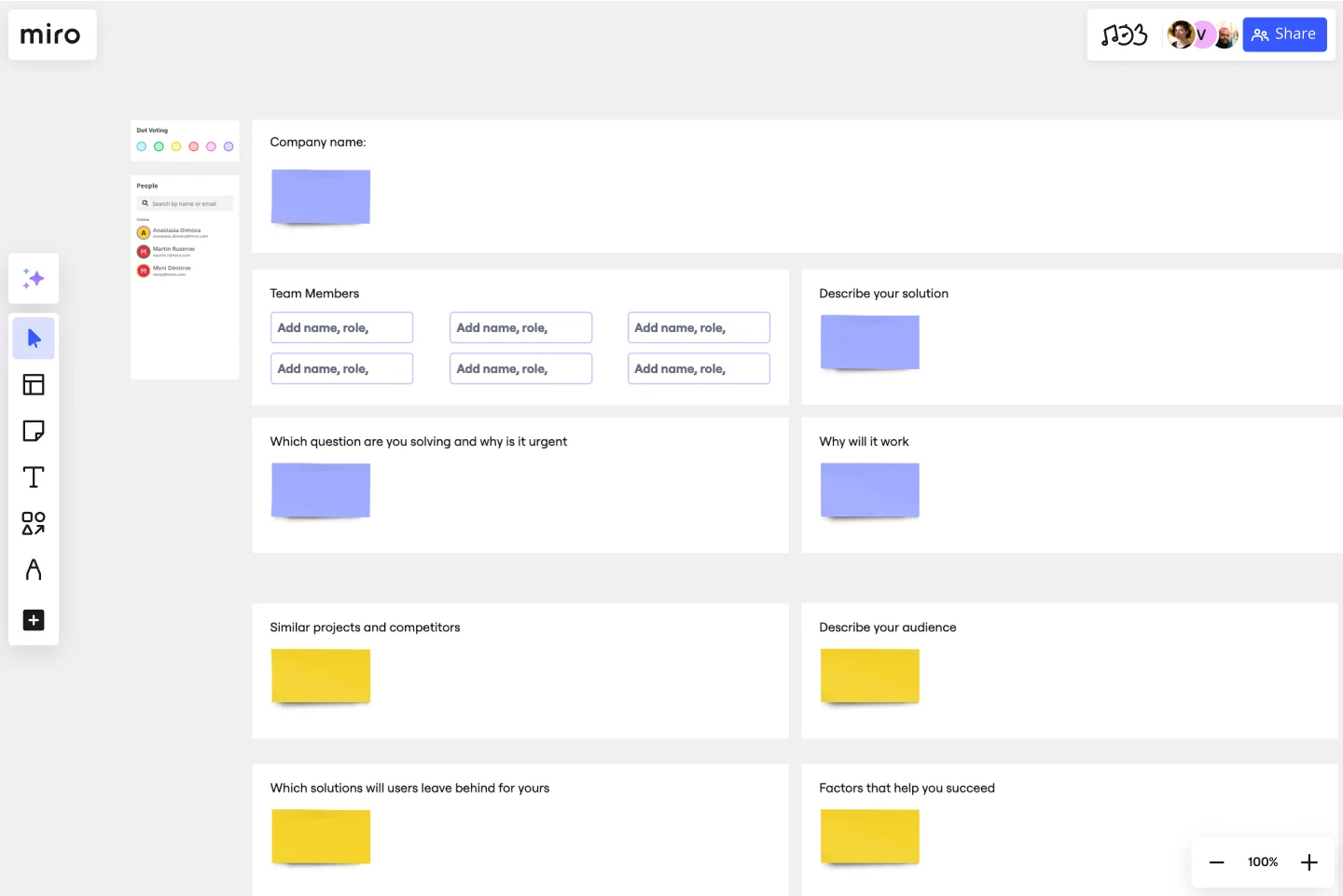Startup Canvas Template
Use this Idea Canvas Template as a useful visual map for founders who want to judge their new business idea's strengths and weaknesses. Share all your important start-up activities and information on just one single page.
About the Startup Canvas Template
Startup canvases are a useful visual map for founders who want to judge their new business idea’s strengths and weaknesses.
By articulating factors like success, viability, vision, and value to the customer, founders can make a concise case for why a new product or service should exist and get funded.
Need a canvas that helps you map out the profitability of your startup idea? That sounds like a Lean Canvas. If you have an existing business model you’d like to visualize, try out the Business Model Canvas.
What is a startup canvas?
A startup canvas helps founders express and map out a new business idea in a less formal format than a traditional business plan.
This canvas can be used as a framework to quickly articulate your business idea’s value proposition, problem, solution, market, team, marketing channels, customer segment, external risks, and key performance indicators.
Create your own startup canvas
Get started by selecting the startup canvas template, then take the following steps to make one of your own:
1. Name your business and confirm your team
Even if you haven’t registered a business name yet, the company name segment can be a space to brainstorm what you’ll call your new venture. Assemble the name of your dream team and on the details with you too.
2. Fill in each customer-related segment
From what your company stands for to your vision, values, each piece will help clarify your idea. Use each “statement” to start drafting key points based on understanding your customer’s key problems – and how your business idea offers a genuine solution.
3. Add at least two to three points for each customer-related segment
Each segment can contain at least three relevant ideas. For example, what are three market research insights or statistics that prove your business idea’s viability?
4. Check the confidence of your language
A startup canvas helps you turn broad ideas into a research-backed concept. Use clear, concise language instead of hedging statements (such as “but” or “however”). Your goal is to turn unaware investors into engaged business prospects.
5. Share the canvas with your team
After you’ve filled in all the segments, share the filled-in startup canvas template with team members or potential investors to get feedback and keep refining your business idea.
Get started with this template right now.
Project Proposal Template
Works best for:
Project Management, Documentation, Project Planning
For any type of project, the Project Proposal template can be a crucial step toward clarifying the context, goals, and scope of a project to get stakeholder buy-in. A project proposal outlines what you want to accomplish, your goals, and how you plan to achieve them. Generally, a project proposal gives the reader some context on the project, explains why it is important, and lists the actions that you will take to complete it. Project proposals have myriad uses. Often, businesses use project proposals to get external buy-in from a donor or outside stakeholder. But many companies draw up project proposals for internal buy-in too.
BCG Matrix Template
Works best for:
Strategic Planning
Use the BCG matrix template to make informed and strategic decisions about growth opportunities for your business. Assign your portfolio of products to different areas within the matrix (cash cows, dogs, question marks, stars) to prioritize where you should invest your time and money to see the best results.
IT Project Timeline
Works best for:
Timeline, Planning
The IT Project Time Line template is essential for managing IT projects efficiently. It allows you to visualize project milestones, deadlines, and key tasks in a clear, chronological format. Track progress, allocate resources, and ensure timely delivery of your IT projects. Ideal for project managers and IT teams aiming to stay organized and meet critical deadlines.
REAN Template
Works best for:
Marketing, Strategic Planning, Meetings
First introduced in Cult of Analytics, the REAN model is used to measure and understand the efficacy of marketing efforts. REAN stands for Reach, Engage, Activate, and Nurture, the main stages a marketer’s audiences experience during a typical journey. The REAN model helps marketing teams develop useful KPIs that can help capture how well their marketing or ad campaigns are working. Many teams rely on the REAN model because it is adaptable to a variety of marketing efforts, including planning measurement frameworks, setting goals, deciding on objectives, and mapping digital marketing channels.
Timelining
Works best for:
Planning, Timeline
Timelining is a versatile template designed for creating detailed project timelines. It allows you to outline tasks, milestones, and deadlines, helping you manage projects efficiently. Whether for business or personal use, this template ensures you stay organized and on schedule.
Objectives and Key Results (OKRs) Template
Works best for:
Leadership, Strategic Planning, Project Planning
Clarity, focus, and structure — those are the key ingredients to feeling confident in your company’s directions and decisions, and an OKR framework is designed to give them to you. Working on two main levels — strategic and operational — OKRs (short for objectives and key results) help an organization’s leaders determine the strategic objectives and define quarterly key results, which are then connected to initiatives. That’s how OKRs empower teams to focus on solving the most pressing organizational problems they face.
